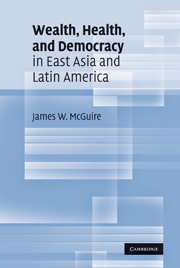Book contents
- Frontmatter
- Contents
- Figures and Tables
- Preface and Acknowledgments
- Abbreviations
- 1 Incomes, Capabilities, and Mortality Decline
- 2 Democracy, Spending, Services, and Survival
- 3 Costa Rica: A Healthy Democracy
- 4 Chile: The Pinochet Paradox
- 5 Argentina: Big Welfare State, Slow Infant Mortality Decline
- 6 Brazil: From Laggard to Leader in Basic Health Service Provision
- 7 Taiwan: From Poor but Healthy to Wealthy and Healthy
- 8 South Korea: Small Welfare State, Fast Infant Mortality Decline
- 9 Thailand: Democratization Speeds Infant Mortality Decline
- 10 Indonesia: Authoritarianism Slows Infant Mortality Decline
- 11 Wealth, Health, Democracy, and Mortality
- Appendix Tables
- Works Cited
- Index
5 - Argentina: Big Welfare State, Slow Infant Mortality Decline
Published online by Cambridge University Press: 06 July 2010
- Frontmatter
- Contents
- Figures and Tables
- Preface and Acknowledgments
- Abbreviations
- 1 Incomes, Capabilities, and Mortality Decline
- 2 Democracy, Spending, Services, and Survival
- 3 Costa Rica: A Healthy Democracy
- 4 Chile: The Pinochet Paradox
- 5 Argentina: Big Welfare State, Slow Infant Mortality Decline
- 6 Brazil: From Laggard to Leader in Basic Health Service Provision
- 7 Taiwan: From Poor but Healthy to Wealthy and Healthy
- 8 South Korea: Small Welfare State, Fast Infant Mortality Decline
- 9 Thailand: Democratization Speeds Infant Mortality Decline
- 10 Indonesia: Authoritarianism Slows Infant Mortality Decline
- 11 Wealth, Health, Democracy, and Mortality
- Appendix Tables
- Works Cited
- Index
Summary
Of the eight societies compared in this book, Argentina from 1960 to 2005 had not only the slowest GDP per capita growth and the greatest rise of income inequality, but also the smallest rise of life expectancy and the second-smallest decline of infant mortality (Tables A1–A4). Much has been written about Argentina's economic problems, but little attention has been paid to its sluggish progress at reducing the risk of early death. Slow economic growth and soaring income inequality kept mortality rates from falling quickly, but just as important were the failures of successive Argentine governments to provide adequate basic social services, especially maternal and infant health care, to the poor. The precariousness of democratic traditions, the Peronist lock on the votes of the poor, and the strength of interest groups help to explain why the heterogeneous governments that administered Argentina from 1960 to 2005 wound up with uniformly undistinguished records of providing basic social services to the people most in need of them.
To develop these arguments, Argentina will be compared particularly to Chile and to one of its own subnational units, the Patagonian province of Neuquén, which in 2001 had about 475,000 of Argentina's 36 million inhabitants. Chile and Neuquén each did better than Argentina as whole at reducing infant mortality (as well as mortality at older ages). From 1960 to 2005 infant mortality fell from 120 to 8 per 1000 in Chile and from 118 to 9 per 1000 in Neuquén, but only from 62 to 13 per 1000 in Argentina.
- Type
- Chapter
- Information
- Wealth, Health, and Democracy in East Asia and Latin America , pp. 120 - 148Publisher: Cambridge University PressPrint publication year: 2010



